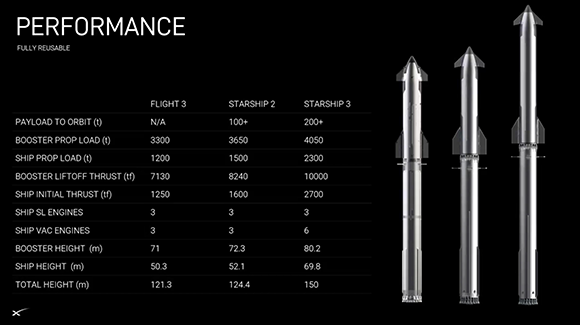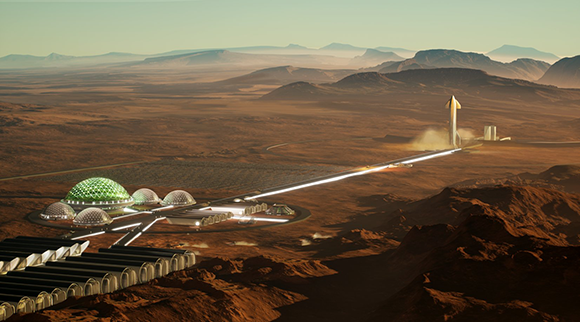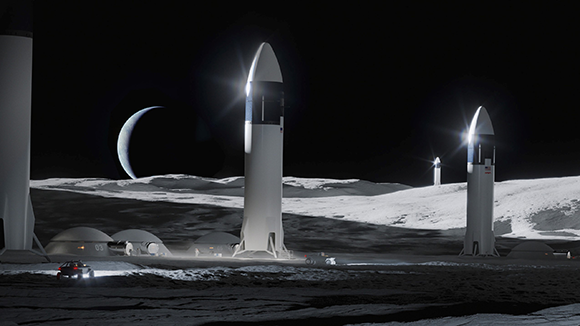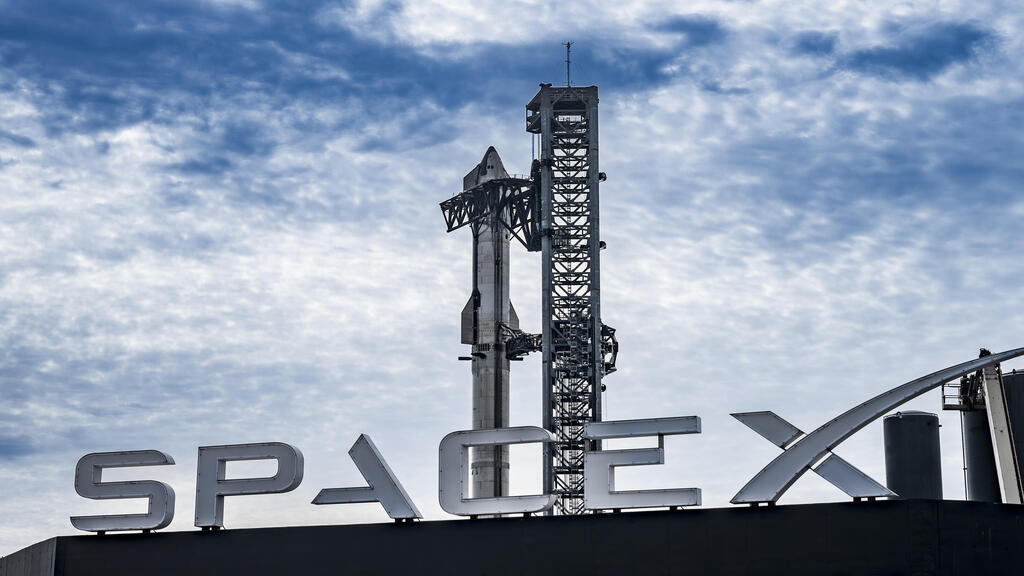Getting your Trinity Audio player ready...
Elon Musk, the founder and CEO of SpaceX, outlined his vision years ago to transport humanity to Mars using the Starship spacecraft. Last weekend, a year after Starship's first trial and a few weeks after the third trial, Musk unveiled an updated plan, which includes the establishment of an independent colony on Mars within two decades.
Musk addressed SpaceX employees at the company's Boca Chica space base in South Texas. He reiterated the imperative of transforming humanity into a multi-planetary species, transcending the constraints of a single planet, and, in the distant future, into an interstellar species, not confined to a single solar system.
Mars stands as the primary candidate for human settlement, currently representing the sole viable option. To realize this monumental goal, SpaceX developed the Starship system, a massive spacecraft capable of vertical landing and reusability that can be launched repeatedly. Its launch vehicle, Super Heavy, is also designed for multiple deployments. The entire assembly of the spacecraft and the launch vehicle is collectively referred to as Starship, though this can be somewhat confusing.
In Starship's third trial, conducted in March 2024, the spacecraft achieved its designated space trajectory for the first time, followed by re-entry into the Earth's atmosphere over the Indian Ocean. However, the intended activation of its engines in space and subsequent targeted crash into the sea encountered technical failures. The spacecraft failed to reactivate its engines for a controlled descent and ultimately disintegrated during re-entry. Additionally, the launch vehicle, which was supposed to perform a landing maneuver over water and then crash into the sea, exploded before completing its mission.
In his Saturday speech, Musk expressed hope that the spacecraft would successfully withstand the heat during re-entry in its fourth experimental flight, scheduled for a few weeks later. In the future, plans to implement a novel landing technique for the launch vehicle, and in some cases the spacecraft itself, involving a specialized tower equipped with mechanical arms to gently guide the hovering rocket to the ground. In the forthcoming flight, Musk said, the rocket will attempt a landing with a virtual tower over the sea, executing the vertical stabilization maneuver while hovering, before crashing into the water. A successful virtual maneuver would pave the way for its real-world counterpart to be tested in the subsequent fifth flight.
4 View gallery


A formidable launch system poised to surpass all predecessors. Starship 3, on the right, compared to the two preceding models
(Photo: SpaceX)
A successful virtual maneuver would pave the way for its real-world counterpart to be tested in the subsequent fifth flight. The maneuver is more challenging concerning the spacecraft, due to its high-speed descent from space. Musk stated that the company would want to record at least two consecutive successes in such a maneuver over the sea before attempting to land the spacecraft at its Texas launch base, to reduce the potential risk of debris and shrapnel scattering over the United States and Mexico in the event of a malfunction.
Higher, Stronger
Presently, Starship launches are performed exclusively only from SpaceX's facility in Texas, but the company has already started building a suitable launch pad at the Kennedy Space Center in Florida, where it launches most of its rockets. Musk has revealed that the company is constructing two launch pads there, with the first anticipated to become operational by the middle of next year. Along with an additional launch pad under construction at Boca Chica, this will bring the total to four active Starship launch facilities by the end of next year. Trials will continue in Texas, while routine operational launches will shift to Florida.
The main innovation in Musk's remarks was the presentation of the future model of Starship, called Starship 3. Following the completion of trials, SpaceX plans to initiate flights using Starship 2, which is slightly larger than the models currently being tested: it will be about 52 meters tall, compared to about 50 meters in the current version, and will be capable of transporting a payload of at least 100 tons to Earth’s orbit. The upcoming Starship 3 will be nearly 70 meters in height, equipped with nine engines instead of six, and capable of carrying over 200 tons of payload to Earth’s orbit. For comparison, the Saturn V rocket, which launched the Apollo spacecraft to the moon, carried a payload of about 140 tons to Earth’s orbit.
In parallel with upgrades to the spacecraft, the company is also developing a new model of Raptor engines, utilized both in the launch vehicle and in Starship itself. Musk presented the ex-generation engine, Raptor 3, which is anticipated to withstand harsh conditions, particularly heat, owing to an internalized design for components that are currently installed externally. Additionally, Raptor 3 will provide stronger thrust and will be easier to manufacture due to the improved design.
The key to Starship missions to Mars, or any other destination, will be refueling in Earth orbit—a technology that has not yet been tested, in part due to the challenges of transferring large quantities of liquids in microgravity conditions. SpaceX has already commenced the third experimental flight of Starship to evaluate technologies for fuel transfer between tanks. The long-term plan envisions Starship vessels loaded with cargo to Mars or other destinations reaching Earth orbit with nearly depleted fuel tanks, having consumed most of their fuel to bring the payload into orbit. There, they will connect to refueling ships that will replenish their tanks, before setting off to their distant destination.
Conquering Mars
Given the differing orbital speeds of Earth and Mars around the sun, launches to the Red Planet are possible only during specific windows when the two planets are relatively close, resulting in a journey lasting typically 6 to 9 months. These potential launch windows to Mars occur every 26 months. According to Musk’s vision, it should be possible to launch up to ten Starship spacecraft per day during these time windows. Once fueled, these spacecraft will await the opportune moment to initiate their journey toward Mars.
Musk proposes that each craft, carrying 200 tons of cargo, could collectively transport 250,000 tons of equipment to Mars during each launch window, culminating in delivery of one million tons of essential supplies to the neighboring planet over an approximate span of about eight years. Musk believes that establishing a functioning and self-sustainable colony on Mars, capable of producing and meeting all its needs independently without reliance on Earth, requires the migration of a million people and several million tons of cargo. He believes this goal can be achieved within twenty years. This ambitious endeavor entails the construction of thousands of spacecraft per year, a feat that Musk deems entirely feasible and comparable to current automotive industry scales.
4 View gallery


According to Musk, a self-sustaining Mars colony that would be independent of Earth could be established within 20 years. Visualization of SpaceX’s Mars Colony
(Photo: SpaceX)
Such a colony would need to develop, among other things, energy sources and methods for their production, mining methods for ice and minerals, long-term life support systems, construction methods and technologies utilizing local materials, and a global communication system. According to Musk's vision, the need for new technologies opens up many opportunities for entrepreneurs and offers new horizons for companies entering these markets.
According to his plan, most of the Starship spacecraft launched to Mars will not return from there but will instead undergo recycling for colony needs. The spacecraft, constructed from stainless steel, could be melted down and recycled to produce tools, building materials, and more. Later, some of the spacecraft will be launched back to Earth after refueling, utilizing resources harvested from the Martian atmosphere and from the ice in its soil, notably methane (CH4) and oxygen (O2). Ultimately, this could establish regular, albeit slow, two-way traffic between Earth and Mars.
The Cost of Success
Central to realizing the grand plan is a significant reduction in launch expenses. Musk is convinced that by implementing mass production techniques for thousands of spacecraft and rockets per year, using affordable and readily available fuel, and fully recycling these crafts and rockets, the cost of launching a Starship could drop to just $2-3 million. While this might still seem costly, it is notably less than the price of launching "Falcon 1", which the company launched at the beginning of its journey in 2006, capable of carrying less than 200 kilograms of payload into Earth orbit.
In the meantime, the company is financing most of Starship’s production and development from its two main projects: the Starlink satellite communication network, which includes more than 6,000 satellites serving close to three million customers, and launches to Earth orbit utilizing the Falcon 9 rocket, SpaceX's trusted workhorse. These rockets deploy satellites for many commercial and governmental clients, as well as crewed and uncrewed Dragon spacecraft to the International Space Station. Currently, until Boeing finally launches its crewed spacecraft, SpaceX remains the sole American entity launching astronauts into space, serving both NASA and private companies such as Axiom.
SpaceX is engaged in many other projects, notably NASA's effort to return humans on the moon again as part of the Artemis program. Starship has been selected by NASA as the designated crewed landing vehicle for the program's initial missions, and potentially also in subsequent endeavors.For these purposes, SpaceX is developing a lunar version of Starship, equipped with appropriate landing legs and devoid of the heat shield and steering fins needed for atmospheric reentry. NASA officially plans a crewed landing on the moon by the end of 2026, though it is more realistically expected to occur two or three years later.
4 View gallery


A testing ground for technologies en route to Mars. SpaceX's envisioned lunar base
(Photo: SpaceX)
The company's agreement with NASA does not grant the space agency exclusive rights to use the lunar landing vehicle, allowing SpaceX to sell it to other space agencies or use it for private missions. Indeed, SpaceX has expressed intentions to establish a Moon base, as briefly mentioned by Musk in his recent address. Such a base, if realized, would likely serve SpaceX or its clients as a testing ground for technologies destined for Mars exploration
Meanwhile, SpaceX is solidifying its status as the foremost operator in Earth’s orbit. According to Musk, about 90 percent of orbital activity is attributable to SpaceX, primarily driven by the Starlink satellites. Musk notes that approximately 90 percent of orbital activity is attributable to SpaceX, primarily due to the Starlink satellites. China accounts for an additional six percent, with the remaining four percent distributed among other global entities.
SpaceX's dominance is expected to increase once Starship becomes fully operational. Well before routine Mars flights become a reality, it's likely that these sizable spacecraft, if they deliver on their promise of low launch costs, will be used not only for deploying large payloads such as space stations but also for satellite deployment and other spacecraft missions. Musk estimates that his company could eventually control 99 percent of activity in Earth orbit. While this goal may sound ambitious and aspirational, judging by SpaceX's progress so far, it is by no means unattainable.


